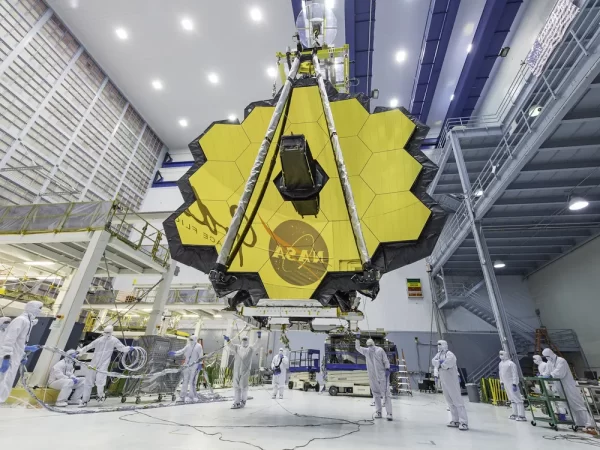 Last updated: August 25, 2024
Last updated: August 25, 2024
Having this website allows me to respond to events and to share information I get when I research things that really interest and excite me. I was so excited to find out that the Sisters of Earth conference just coincidentally happened on the exact same week back in July 2022, when NASA released the first stunning images from the James Webb Space Telescope – really a kind of synchronicity to be honest. The Universe is astoundingly beautiful!
It’s been over a year since the conference, so I thought I would just finish up this blog post I was working on back then, in order to tell you how the telescope was developed, what the initial images released were, and a little about the more recent research being done with the James Webb Space Telescope (JWST.) Hopefully I will be able to communicate it in a way that is not impossible to understand.
I retired from being an engineer for NASA at Johnson Space Center in Houston last year, after working there for 32 years. I did not work on the JWST, but I can personally testify to the amazing amount of skill and resources (in all of the particularities that I am familiar with) that have brought us to this moment with this particular telescope. I highly recommend watching this July 2022 NOVA special about the development of the Webb Telescope. Like all NASA programs, the telescope had a fair amount of risk to it and, unlike the Hubble Telescope, there would be no possibility of a human repair mission.
Yes, the astrophysicists and other scientists had to wait a very long time for this telescope to become operational. However, I want to honor and celebrate all of the behind-the-scenes engineers and technicians who actually designed, built, and tested this amazing piece of technology. Their dedication, persistence, and sustained effort for so many years is incredible.
![]()
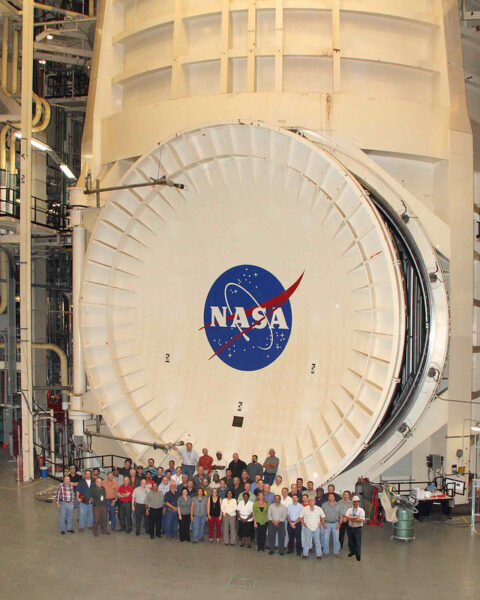 The JWST was built in collaboration with the European Space Agency and the Canadian Space Agency, and it was physically in-work for 19 years. The cost for those 19 years totaled about $10 billion, which includes the entire project. The picture above and to the left shows the primary mirror that was constructed from eighteen gold-plated beryllium hexagonal mirrors, as they were being positioned inside a clean room at NASA’s Goddard Space Flight Center in Greenbelt, Maryland. You can see that the workers in the photo are dressed in “bunny suits” to protect the cleanliness of the hardware. The Webb Space Telescope was built with the following four key objectives in mind:
The JWST was built in collaboration with the European Space Agency and the Canadian Space Agency, and it was physically in-work for 19 years. The cost for those 19 years totaled about $10 billion, which includes the entire project. The picture above and to the left shows the primary mirror that was constructed from eighteen gold-plated beryllium hexagonal mirrors, as they were being positioned inside a clean room at NASA’s Goddard Space Flight Center in Greenbelt, Maryland. You can see that the workers in the photo are dressed in “bunny suits” to protect the cleanliness of the hardware. The Webb Space Telescope was built with the following four key objectives in mind:
-
- to search for light from the first stars and galaxies that formed in the universe after the Big Bang
- to study galaxy formation and evolution
- to understand star formation and planet formation and
- to study planetary systems and the origins of life.
Like the human spaceflight programs that I worked on, the design, build, test and operate process went somewhat like this: design – preliminary design review – design and redesign – critical design review – redesign – build qual unit – perform qual test – resolve anomalies and test again – resolve anomalies – build flight hardware – acceptance test – resolve anomalies – ship – resolve anomalies – launch – orbit insertion – calibrate – then finally ready to begin operations. It’s a lengthy and somewhat iterative process, but it is planned to find the technical weaknesses and correct them ahead of time, so that all will go right when the hardware launches.
Webb Telescope Timeline Highlights:
The Webb Telescope began many years ago – the primary contract was awarded way back in 2003. After a lot of slow preliminary work, the program narrowly averted cancellation in 2011. But work continued, and the first combined test was performed in June 2014. The manufacturing of the hex segments for the primary mirror was completed in February 2015. Preliminary cryogenic tests were completed in November 2016.
Work continued, and a vibration test anomaly had to be resolved in December 2016. Vibration tests are very important during hardware development, because workmanship needs to be ironed out and verified, in order to avoid anomalies during its operational lifetime, when it matters most.
In May 2017, the primary mirror arrived at the NASA Johnson Space Center cleanroom prior to final cryogenic testing. The test team had been making plans for years ahead of time for this full size test that used Vacuum Chamber A to simulate the frigid vacuum of space. The cleanliness of the chamber was critical because contamination of the mirrors could seriously degrade the operability of the Webb Telescope. Cleanliness includes absence of both particulate and organic residues. A photo of the test team next to Chamber A is shown above and to the right.
 Additional technical issues were found in March 2018, when the sunshield snagged during testing. This event resulted in a comprehensive investigation and was part of the reason that, in June 2018, an Independent Review Board was established. Its purpose was to survey both technical and managerial issues associated with the space telescope program overall. As expected, these developments and the review board findings led to a launch date postponement. Then, the schedule was further impacted by the COVID pandemic and new launch dates were proposed in July 2020. Unfortunately, schedule slippage is pretty common, so NASA engineers and scientists definitely need to have a lot of patience.
Additional technical issues were found in March 2018, when the sunshield snagged during testing. This event resulted in a comprehensive investigation and was part of the reason that, in June 2018, an Independent Review Board was established. Its purpose was to survey both technical and managerial issues associated with the space telescope program overall. As expected, these developments and the review board findings led to a launch date postponement. Then, the schedule was further impacted by the COVID pandemic and new launch dates were proposed in July 2020. Unfortunately, schedule slippage is pretty common, so NASA engineers and scientists definitely need to have a lot of patience.
The final flight hardware arrived at the launch site on October 12, 2021, after a 16-day journey by sea from California through the Panama Canal to French Guiana. On November 22, 2021, the launch was delayed because of an unplanned clamp release in final checkouts. Then, on December 15, 2021, an electronics glitch caused a communications error that forced another delay. And yet again, the space telescope launch was scrubbbed on December 21, 2021 for an adverse weather delay at the launch site facility in Kourou.
 After so much work by so many engineers and scientists, over the lifetime of the hardware design, build, and testing, the launch of the European Space Agency’s Ariane 5 vehicle with the JWST flight hardware finally occurred on Christmas, December 25, 2021. The image above right is of the launch, and the photo to the left is just after separation from the Ariane 5, approximately 29 minutes after launch.
After so much work by so many engineers and scientists, over the lifetime of the hardware design, build, and testing, the launch of the European Space Agency’s Ariane 5 vehicle with the JWST flight hardware finally occurred on Christmas, December 25, 2021. The image above right is of the launch, and the photo to the left is just after separation from the Ariane 5, approximately 29 minutes after launch.
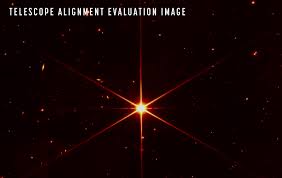 The Webb Telescope arrived at its destination, Sun-Earth Lagrange point 2, on January 24, 2022, and the mirror alignment calibrations were completed on March 21, 2022, as-verified in the alignment image at right. I was somewhat amazed to learn that the mirror alignment process actually began during the journey to the Lagrange point. I would have thought that it would have been too adversely affected by vibration, but apparently not. Equally impressive, the operations team appeared to easily correct the mirrors when a micrometeorite impact was detected early in the telescope’s operation. This reflects positively on the engineers, who had anticipated this potential problem and designed the mirror so that it could accomodate and adjust for this complicating factor.
The Webb Telescope arrived at its destination, Sun-Earth Lagrange point 2, on January 24, 2022, and the mirror alignment calibrations were completed on March 21, 2022, as-verified in the alignment image at right. I was somewhat amazed to learn that the mirror alignment process actually began during the journey to the Lagrange point. I would have thought that it would have been too adversely affected by vibration, but apparently not. Equally impressive, the operations team appeared to easily correct the mirrors when a micrometeorite impact was detected early in the telescope’s operation. This reflects positively on the engineers, who had anticipated this potential problem and designed the mirror so that it could accomodate and adjust for this complicating factor.
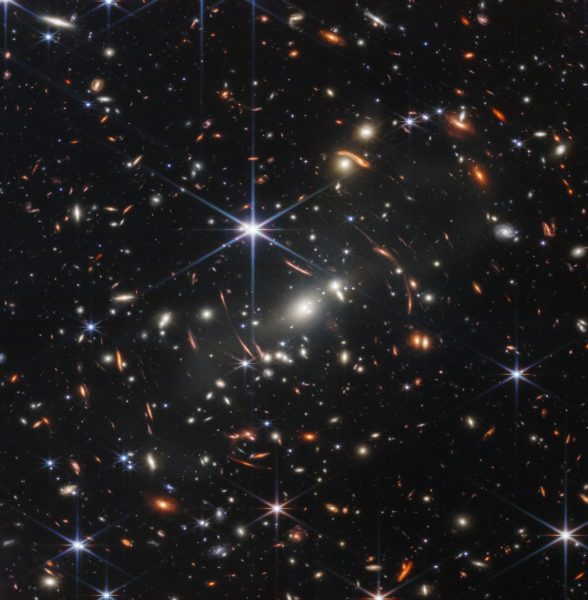 First Images Released – July 11, 2022:
First Images Released – July 11, 2022:
The first images taken by the Webb Telescope were released to the public on July 11, 2022, and below is a description of four of these images. For the first image, the telescope was aimed backwards into time toward the Big Bang – also known as the beginning of the Universe Story. The importance of the telescope is that it is investigating space in the infrared spectrum rather than the visible spectrum (what we can see with our eyes) as previous telescopes normally operated. The space telescope has two instruments that detect infrared radiation – a Near-Infrared Camera (NIRCam) and a Mid-Infrared Instrument (MIRI.) This is because the infrared spectrum is much wider than the visible spectrum and two instruments allow scientists to optimize the results for each of the two ranges – so that there is better resolution.
This composite image at left, named “Webb’s First Deep Field,” is my favorite of the first images released. Looking back in time toward the Big Bang, it was produced using many images at multiple wavelengths of light, collected by the James Webb Space Telescope’s MIRI. It shows the galaxy cluster SMACS 0723 as it was 4.6 billion years ago. There are many galaxies both behind and in front of this cluster. It is the deepest and sharpest infrared image yet of the universe – it reaches back to 100 million years after the Big Bang (currently estimated to have occurred 13.8 billion years ago.) There are thousands of galaxies shown in this image, including the faintest objects ever revealed by infrared technology.
Here is a description of Webb’s First Deep Field, provided at the reference for Image 6: “The background of space is black. Thousands of galaxies appear all across the view. Their shapes and colors vary. Some are various shades of orange, others are white. Most stars appear blue, and are sometimes as large as more distant galaxies that appear next to them. A very bright star is just above and left of center. It has eight bright blue, long diffraction spikes. Between 4 o’clock and 6 o’clock in its spikes are several very bright galaxies. A group of three are in the middle, and two are closer to 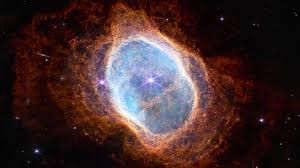 4 o’clock. These galaxies are part of the galaxy cluster SMACS 0723, and they are warping the appearances of galaxies seen around them. Long orange arcs appear at left and right toward the center.”
4 o’clock. These galaxies are part of the galaxy cluster SMACS 0723, and they are warping the appearances of galaxies seen around them. Long orange arcs appear at left and right toward the center.”
On the right is the first JWST image of the Southern Ring Nebula. The dimmer star at the center of this scene is about 2500 light-years away and has been sending out rings of gas and dust for thousands of years in all directions. Here, the Webb Telescope has revealed for the first time that this star is covered in dust. Future work using the JWST will allow astronomers to dig into many more specifics about planetary nebulae like this one – clouds of gas and dust expelled by dying stars. Spectroscopy data, to identify the chemical composition of objects and the distribution of elements, will be relayed to the ground so that researchers can refine their knowledge of nebulas like this one.
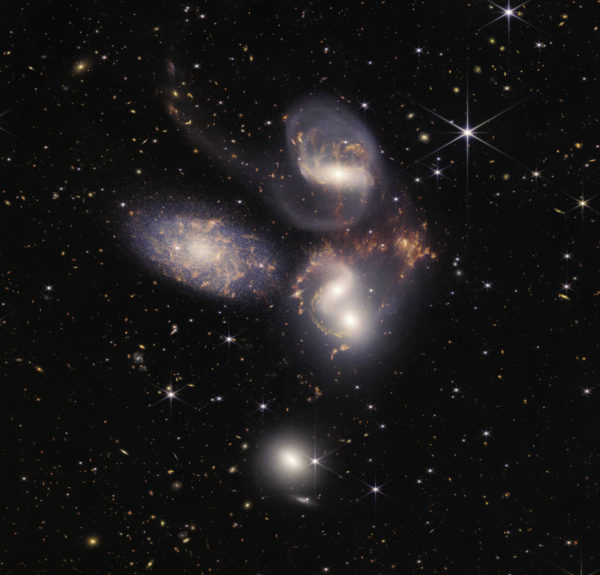 The third JWST image released back in July 2022 was of Stephan’s Quintet. At left, the image shows a grouping of five galaxies. It is an enormous mosaic of images that was Webb’s largest image of the initial images released. It was woven together from almost 1,000 separate image files, covering a surface area of about one-fifth of the Moon’s diameter. The information from the Webb Telescope will provide new insights into how galactic interactions may have driven galaxy evolution in the early universe.
The third JWST image released back in July 2022 was of Stephan’s Quintet. At left, the image shows a grouping of five galaxies. It is an enormous mosaic of images that was Webb’s largest image of the initial images released. It was woven together from almost 1,000 separate image files, covering a surface area of about one-fifth of the Moon’s diameter. The information from the Webb Telescope will provide new insights into how galactic interactions may have driven galaxy evolution in the early universe.
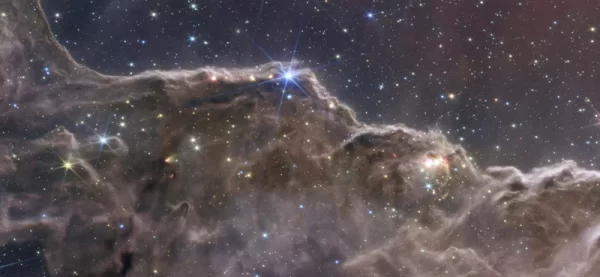 The right hand image shows some “cosmic cliffs,” a young, star-forming region called NGC 3324 in the Carina Nebula. This composite image reveals, for the first time, previously invisible areas of star birth. The nebula is situated 8,500 light-years away from Earth.
The right hand image shows some “cosmic cliffs,” a young, star-forming region called NGC 3324 in the Carina Nebula. This composite image reveals, for the first time, previously invisible areas of star birth. The nebula is situated 8,500 light-years away from Earth.
Latest 2023 Webb Telescope Discoveries:
And that was just the beginning of the research. I highly recommend viewing this February 2023 NOVA episode that covers some of the more recent Webb findings. For example, a study of six massive galaxies that formed between 500 million and 700 million years after the Big Bang revealed that they were more massive than expected. The scientific community expected that only very small baby galaxies would have existed at that time, but instead discovered galaxies as mature as our own. In fact, they were so massive that previous theories, that galaxies formed from small clouds of dust and stars that grew over time, will need to be revised.
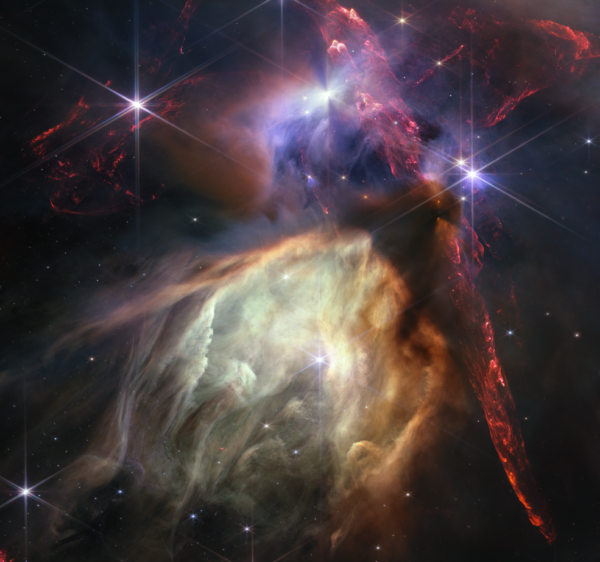 In July 2023, at the one year anniversary of the release of the initial Webb Telescope images, NASA released another stunning, ground-breaking view – this time of a small star-forming region in the Rho Ophiuchi cloud complex. This gorgeous new image at left shows the nearest star-forming region, roughly 390 light-years from Earth.
In July 2023, at the one year anniversary of the release of the initial Webb Telescope images, NASA released another stunning, ground-breaking view – this time of a small star-forming region in the Rho Ophiuchi cloud complex. This gorgeous new image at left shows the nearest star-forming region, roughly 390 light-years from Earth.
According to NASA, this image shows “a region containing approximately 50 young stars, all of them similar in mass to the Sun, or smaller. The darkest areas are the densest, where thick dust cocoons still-forming protostars. Huge bipolar jets of molecular hydrogen, represented in red, dominate the image, appearing horizontally across the upper third and vertically on the right. These occur when a star first bursts through its natal envelope of cosmic dust, shooting out a pair of opposing jets into space like a newborn first stretching her arms out into the world. In contrast, the star S1 has carved out a glowing cave of dust in the lower half of the image. It is the only star in the image that is significantly more massive than the Sun.”
Webb Telescope scientists have been particularly interested in the detailed information that is being collected using the telescope’s spectroscopic instruments. So far, their data collection has allowed them to confirm the distances of some of the farthest galaxies ever observed. They have also discovered the earliest, most distant supermassive black holes and identified the compositions of planet atmospheres (or lack thereof) with more detail than ever before. In addition, scientists have explored the atmospheres on rocky exoplanets and the chemical composition of stellar nurseries and protoplanetary disks.
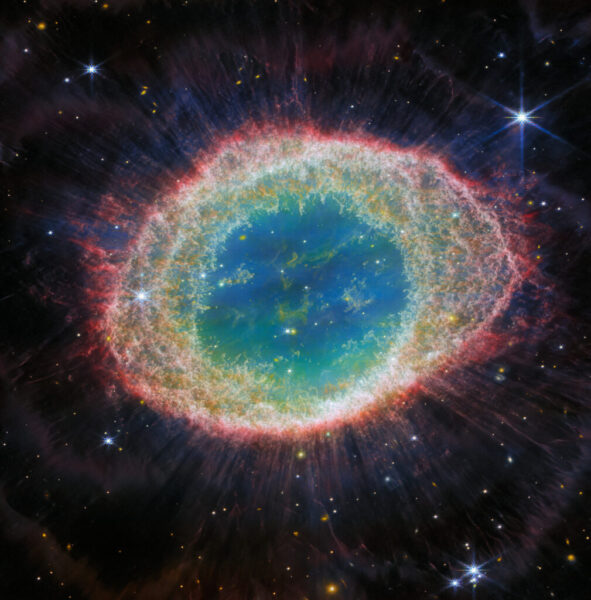
Even more recently, here are two images of the Ring Nebula (also known as M57 and NGC 6720) that were released to the NASA/Webb Telescope blog in August 2023. Similar to the Southern Ring Nebula, the first photograph of the Ring Nebula (at right) was taken using the Webb Telescope’s Near-Infrared Camera (NIRCam.) Roger Wesson, a scientist from Cardiff University, indicated in Reference 6 that there is a narrow band of polycyclic aromatic hydrocarbons within the bright ring that were previously not expected to form within the nebula. Also, the “spikes,” pointing away outside of the bright ring, were only faintly visible in the Hubble images, but are quite prominent in the new infrared images. The scientific community thinks that they may be molecules that form in the shadows of the densest part of the ring.
The second image of the Ring Nebula (below and to the left) was taken with the MIRI instrument, providing the clearest view yet of the molecular halo outside the bright ring. The up to ten regularly-spaced arcs probably formed every 280 years, as the central star was shedding it outer layers. There are currently no known processes that could have achieved this outcome, but the rings may indicate that there is a companion star in the system. Perhaps the Ring Nebula dying star was giving off its atmosphere, that was sculpted or shaped by the companion star.
So that’s all I have for today. I anticipate learning more about The Universe and following the research of the Webb Telescope, as additional information becomes available.
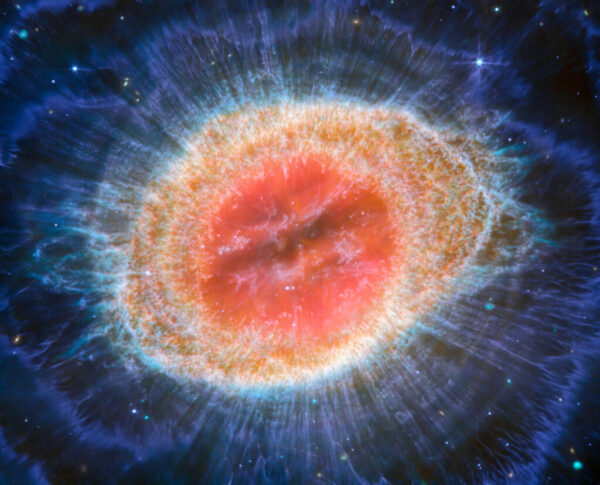
UPDATE: This blog post was updated on October 13, 2023 to make minor editorial changes.
Reference 1: Ultimate Space Telescope, NOVA Season 49, Episdoe 10, Public Broadcasting Service, July 13, 2022.
Reference 2: New Eye on the Universe, NOVA Season 50, Episode 4, Public Broadcasting Serviice, February 22, 2023.
Reference 3: James Webb Space Telescope website, Space Telescope Science Institute, https://webbtelescope.org/.
Reference 4: Ashley Strickland, “Webb Telescope Spots a Surprising Galactic Discovery in the Distant Universe,” CNN, February 23, 2023.
Reference 5: “Webb Celebrates First Year of Science With Close-up on Birth of Sun-like Stars,” James Webb Space Telescope website, NASA News Release 2023-128, July 12, 2023.
Reference 6: Thaddeus Cesari, “Webb Reveals Intricate Details in Remains of Dying Stars,” NASA/Webb blog post, August 21, 2023.
Image 1: James Webb Space Telescope Mirror Seen in Full Bloom, CC BY-2.0-DEED, flickr.com, April 24, 2017.
Image 2: Chamber A, CC BY-2.0-DEED, flickr.com, September 5, 2012
Image 3: Michael Roston, Webb Telescope Launch, Ariane 5 launch from Kourou, French Guiana, New York Times, December 25, 2021.
Image 4: Jeff Foust, “Ariane 5 Launches NASA’s James Webb Space Telescope,” Space News, December 25, 2021, photo credit Arianespace.
Image 5: “NASA’s Webb Reaches Alignment Milestone, Optics Working Successfully,” NASA/STsci nasa.gov, NASA News Release, March 16, 2022.
Image 6: Webbs First Deep Field, NASA/ESA/CSA/STsci, CC BY-2.0-DEED, flickr.com, July 22, 2022.
Image 7: Southern Ring Nebula, NASA/ESA/CSA/STsci, CC BY-2.0-DEED, flickr.com, July 12, 2022.
Image 8: Stephan’s Quintet, NASA/ESA/CSA/STsci, CC BY-2.0-DEED, flickr.com, July 12, 2022.
Image 9: Carina Nebula, NASA/ESA/CSA/STsci, CC BY-2.0-DEED, flickr.com, July 12, 2022.
Image 10: Webb Celebrates First Year of Science With Close-up on Birth of Sun-like Stars, NASA, ESA, CSA, STScI, Klaus Pontoppidan (STScI,) July 12, 2023.
Image 11: Ring Nebula from NIRCam (Near-Infrared Camera,) ESA/Webb, NASA, CSA, M. Barlow (University College London), N. Cox (ACRI-ST), R. Wesson (Cardiff University,) August 21, 2023.
Image 12: Ring Nebula from MIRI (Mid-Range IR Instrument), ESA/Webb, NASA, CSA, M. Barlow (University College London), N. Cox (ACRI-ST), R. Wesson (Cardiff University,) August 21, 2023.















Leave a Reply
Join the conversation by submitting a comment to this blog post below.